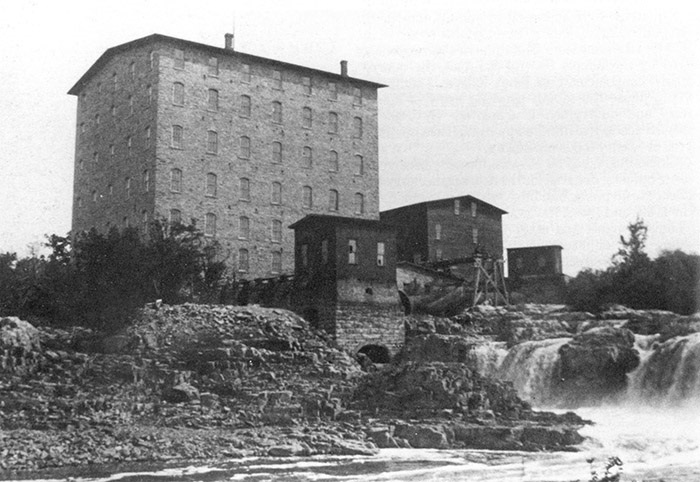PARK HISTORY

The Falls Through Time
The Falls of the Big Sioux River began as a natural wonder, sustaining early tribes and settlers with its beauty and resources. Over time, it powered industrial growth but eventually became neglected and polluted. Today, thanks to the City and Sioux Falls Parks and Recreation’s revitalization efforts, The Falls has once again become a place of beauty, serving as a vibrant community space.
*Images courtesy of the Siouxland Heritage Museums.
Way Back When
1.6 Million B.C.-500 A.D.
It’s hard to imagine a time when The Falls didn’t exist. For you and me, it’s always “just been there.” But it took millions of years to turn The Falls into what we see today. The quartzite bedrock, created over 1.5 billion years ago from ancient seabed sediments, was buried deep beneath the surface. Around 14,000 years ago, the Wisconsin Glacier exposed this ancient rock. As it melted, the flowing water carved its way down, creating the beautiful waterfalls we know today. Archaeological findings, like stone tools, suggest that ancient tribes began to use the surrounding area as a gathering place thousands of years ago.
The Lure of The Falls
1600–1856
The Falls has long been a center of human activity. Native American tribes used the area as a hub for trade and seasonal migration. By the 1600s, European fur traders saw the area as a strategic meeting place for commerce and exchange. The first documented visit by a white explorer was Philander Prescott. The trapper and trader camped briefly in December of 1832. By this time, the promise of harnessing the power of the falls for industrial use drew settlers, and it wasn’t long before visions of a bustling community began to take shape.
Frontier Rivalry
1856–1870
In 1856, two rival town companies—the Western Town Company and the Dakota Land Company—competed to control this prime location. The Western Town Company arrived first, claiming its 320 acres below the falls and naming it “Sioux Falls.” The Dakota Land Company was forced to claim their 320 acres above The Falls. However, the two companies did work together during the Sioux War of 1862. They built a small fortification called "Ford Sod" to help protect their claim. Eventually, the conflict forced settlers to flee, and the area was abandoned until the U.S. government intervened with military support. By 1870, the threat had diminished, and Sioux Falls reopened for settlement.

Queen Bee Mill
1870–1911
Sioux Falls was booming with dreams of industry in the 1870s. One of the most significant industrial projects to rise near The Falls was the Queen Bee Mill. It was constructed in 1881 by Richard Pettigrew after convincing investment capitalist George Seney to view the site and hear about his plans. Mr. Seney was impressed, and he and other investors made the Queen Bee Mill a reality. This ambitious structure was intended to be the heart of Sioux Falls’ industrial growth, leveraging the power of the falls. However, the mill faced many difficulties, and after several operational challenges, it closed in 1883. Its ruins still remain today and serve as a reminder of the city’s industrial aspirations.

The Lost Island
Did you know The Falls used to have an island? Seney Island was a popular spot for picnics and public gatherings and became an important recreational space during the late 1800s. By the 1930s, however, urban development and environmental challenges both led to the island’s disappearance from the visible landscape. The island suffered from neglect and was used as a dumping ground, contributing to its degradation before it was eventually lost forever.
A New Era
1911–Today
After decades of industrial use and neglect, The Falls area underwent a transformation in the early 20th century. Beginning in the 1930s, efforts to mitigate flooding led to extensive construction, including floodwalls and embankments that reshaped the river’s flow. In the latter half of the century, the City aimed to restore and preserve the natural beauty of The Falls. Today, The Falls is a thriving destination where people gather, just as they did in the area’s earliest days, bringing the story of The Falls full circle.